#U.S. forces and soldiers
Text
Remember the Battle of Tulagi and Gavutu–Tanambogo: August 1942.

During the Guadalcanal campaign from August 1942 to February 1943, the Battle of Tulagi and Gavutu-Tanambogo—all small islands in the Solomons—became a grim prelude to the fierce island-hopping battles ahead. While the Allied land forces fighting on nearby Guadalcanal faced much less resistance, U.S. forces on these other three islands were met by an outnumbered Japanese force that fought to protect the island to the last man.
This fierce, almost suicidal Japanese resistance was common throughout the rest of the war in the Pacific, and Americans got their first taste of it on the remote island of Tulagi.
[Up Next: Japan is Building the Biggest Warships in Asia]
#Battle of Tulagi#Guadalcanal campaign#solomon islands#Allied land forces#U.S. forces and soldiers#imperial japanese army#Japanese force#chronology#second world war
3 notes
·
View notes
Text






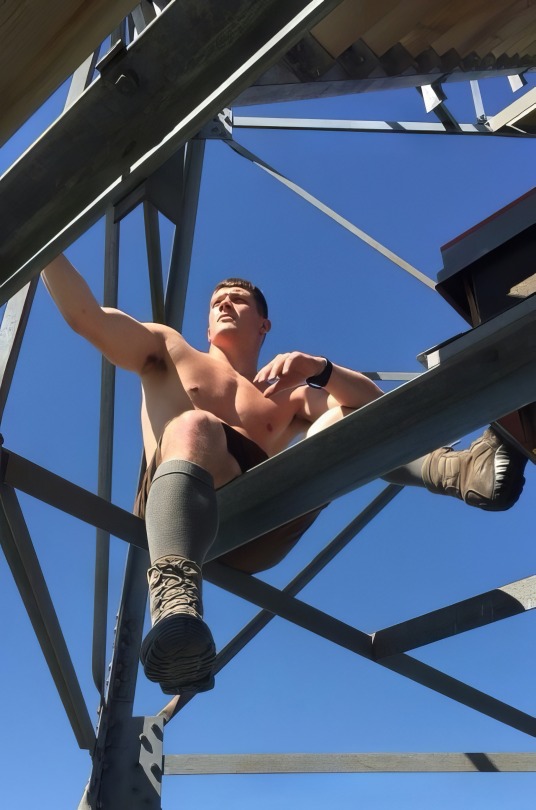


Got another pic of him that I can't post. 😈
#shirtless#muscle#jock#military jock#military#us military#u.s. military#united states armed forces#us army#army#soldier#american soldier#amazing eyes#armpits#smirk#treasure trail#towel#guy taking selfie#mirror#bathroom#uniform#military uniform#boat#boating#lake#outdoors#enlarged 4x#photo enlargement#photo enhancement
441 notes
·
View notes
Text
Memphis Belle
The “Memphis Belle” is a World War II bomber, piloted by a young crew on dangerous bombing raids into Europe. The crew only have to make one more bombing raid before they have finished their duty and can go home. In the briefing before their last flight, the crew discover that the target for the day is Dresden, a heavily-defended city that invariably causes many Allied casualties

Credits:…

View On WordPress
#bomber#danger of life#flying fortress#heroic mission#military airplane#nazi germany#soldier#Top Rated Movies#u.s. air force#world war ii
9 notes
·
View notes
Text
youtube
#youtube#militarytraining#Balikatan 24#Military Readiness#Troop Deployment#Philippines#Jungle Knots#Special Forces#Military Training#Army Rangers#Jungle Survival#Soldiers#Military Operations#Infantry Training#Army Techniques#Military Preparation#Army Drill#Army Skills#Tactical Skills#Combat Training#Military Exercises#U.S. Army
3 notes
·
View notes
Text
He's serious
5 notes
·
View notes
Text

Memorial Day...Flags for the fallen. 🇺🇸🇺🇸🇺🇸🇺🇸🇺🇸
#memorial#memorial day weekend#memorial day#memorial day 2022#memorial day weekend 2022#made in the usa#usa flag#party in the usa#usa flags#usa#united states of america#remember the fallen#unknown soldier#semper fi#us army#army#us air force#Air Force#u.s. navy#navy#us marines#marines#honor#honor and remember#tomb of the unknown soldier#flags#landscape photography#boston photographer#Boston#boston common
53 notes
·
View notes
Text

USO Service Center Valentine's Dance
February 12, 1945: Sergeant Sheldon Coplin (Camp Bowie, TX), Mary Louise Caton, Ruth Quist, and Robert Person decorate the downtown USO Service Men's Center for a Valentine's Day Dance. The Minneapolis USO Service Center opened at 807 Hennepin Ave. in February, 1942. United Service Organizations, popularly known as the USO, formed in 1941, during WWII, with a mission to provide recreation for on-leave members of the U.S. armed forces--soldiers, sailors, marines, and coast guardsmen--and their families.
See more photos of the Minneapolis USO Service Center in the Minneapolis Newspaper Photograph Collection in the Hennepin County Library Digital Collections.
#Minneapolis#Minnesota#Valentine's Day#WWII#U.S. armed forces#soldiers#sailors#United Service Organizations#USO#dances#February#1940s
7 notes
·
View notes
Video
#NASKW#Stinger#OHANG#national guard#NG#national#guard#guardsman#guardsmen#soldier#soldiers#airmen#airman#u.s.#army#air#force#united#states#america#USA#military#troops#2022#NAS Key West#Florida#United States#OH#OHNG#Ohio
8 notes
·
View notes
Text
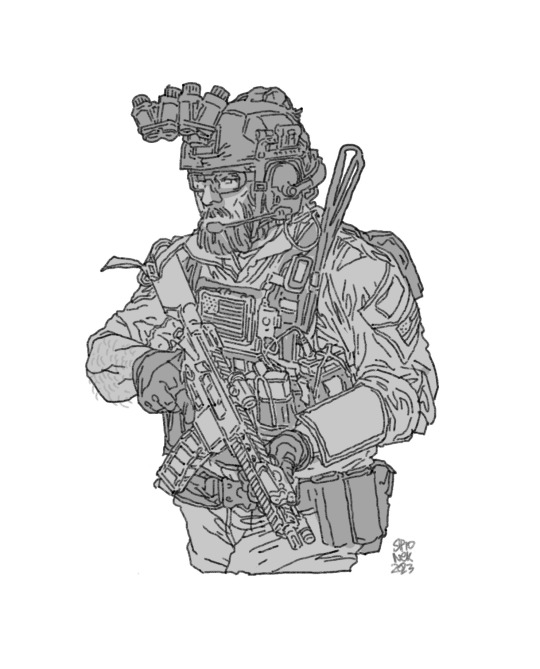
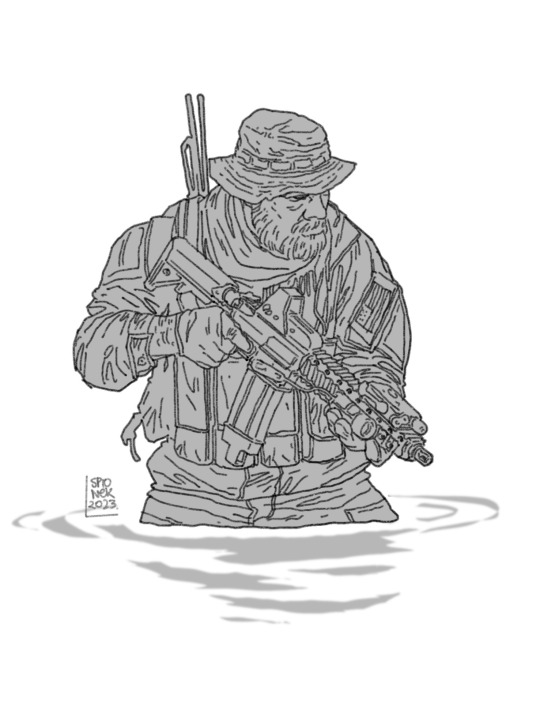
#military#devgru#seal team#u.s. army#army#soldier#specialforces#delta force#sketchbook#sketch#drawings#comics#illustration#comic books#art#comic#drawing#artist
3 notes
·
View notes
Text
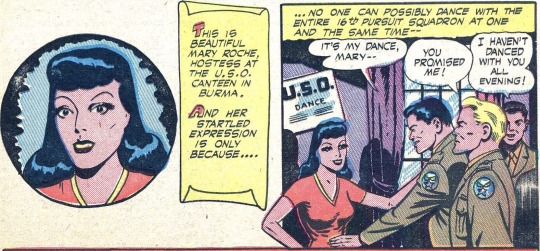
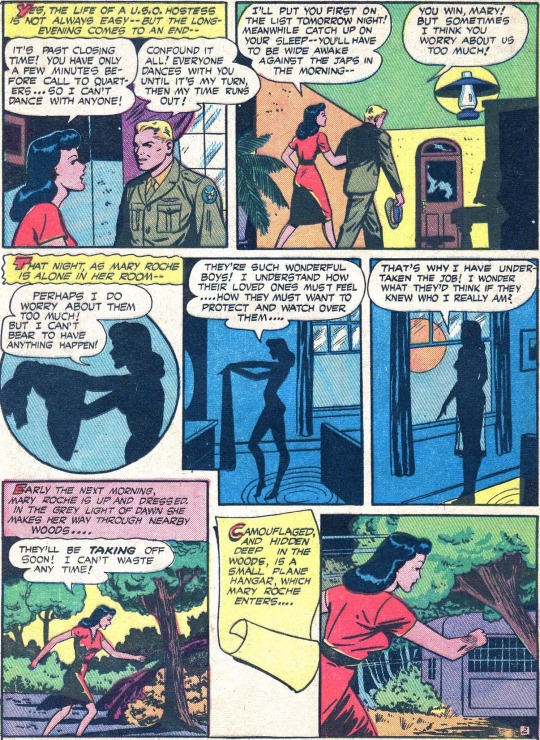

Contact Comics (1944) #1
#so in this story her superhero role is presented that she secretly follows the pilots around in her own plane#and when they get in trouble she intervenes which gives them the opportunity to take control of the battle#and then she flies off#I imagine that that’ll be carefully balanced as to not ever portray the pilots as incompetent#and after that fight she lands her plane and ends up getting captured by Japanese soldiers#who she’s able to escape from on her own and destroy their equipment in the process#which I imagine is a kind of setting shift that allows them to portray stakes (her getting kidnapped)#without reflecting badly on the U.S.’ pilots#the way she talks about the men here stands out to me#she’s overall very charmed by them#‘They’re all such wonderful boys!’#again tying into the very pro U.S. forces messaging of this comic#aviation press#black venus#my posts#comic panels#racist language tw
2 notes
·
View notes
Text
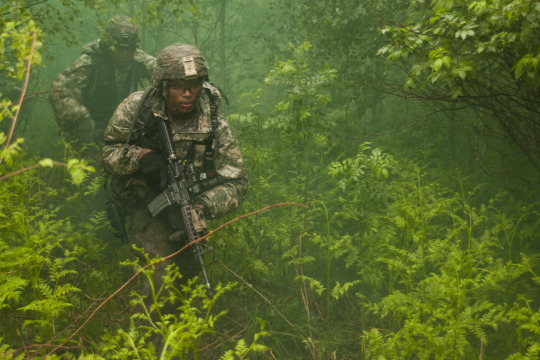
U.S. Army paratroopers during squad-level live-fire training near Tapa, Estonia.
Photo by Sgt. Anthony Jones, 145th MPAD, Oklahoma Army National Guard (2014).
#military 1st#military#army#us armed forces#us army#u.s. army#u.s. military#camouflage#camo#soldiers#us soldiers
4 notes
·
View notes
Text
Remember the Battle of Bataan: January–April 1942.

After the surprise attack on Pearl Harbor in December 1941, the Japanese launched a major offensive in the Philippines that eventually led to U.S. forces and soldiers of the Philippine Commonwealth to be cornered on the Bataan peninsula in the Philippines. Under direct orders from President Franklin Roosevelt, a reluctant General Douglas MacArthur escaped from Bataan to Australia, vowing one day to return and continue the fight.
Allied forces held off Japanese troops for three months, which stymied Japan’s hopes of growing its territorial gains in the Pacific theater. However, on April 9, 1942, 76,000 Allied troops surrendered to the Imperial Japanese Army; the transfer of those POWs from the battle became known as the Bataan Death March due to the physical abuse and arbitrary killings of prisoners along the way. “Remember Bataan” became a popular rallying cry for the U.S. war effort.
[Did You Know? The U.S. Never Successfully Fielded an Instant Foxhole Bomb, But Russia Sure Did]
#Battle of Bataan#second world war#Bataanpeninsula#Allied troops#Imperial Japanese Army#chronology#U.S. forces and soldiers
0 notes
Text
Israeli Caterpillar bulldozers are so symbolic of settler violence and brutality towards Palestinians; they are literal death machines. D9 bulldozers are sold by Caterpillar Inc., based in the US, and are equipped with armor and can be fitted with machine guns and grenade launchers. The nickname for these machines in Israel is "Doobi" - meaning teddy bear.
In 2004, Human Rights Watch called on Caterpillar to suspend bulldozer sales to Israel because of their use in the demolition of Palestinian property and infrastructure. Caterpillar makes military specifications for the D9 and sells them to Israel as weapons under the U.S Foreign Military Sales program, upon arrival, they are armored by Israel Industries Ltd. Before Israel pulled out of the Gaza Strip in 2005, D9s were used to demolish over 2,500 Palestinian homes in Gaza, most being in Rafah where the Israeli Government tried to expand a "buffer zone" along the border with Egypt. This was almost 20 years ago.
During these demolitions within Gaza, Rachel Corrie, an American activist who had been protesting against these home demolitions across the occupied territories, was buried with dirt by an Israeli bulldozer and repeatedly run over. Israeli military sources blamed her and the other activists who were protesting the demolitions, the IDF investigations found themselves not to blame, and no charges were brought for her murder (In the aftermath of her death, Israeli soldiers made fun of her through Facebook communities called "Rachel Corrie Pancakes and Fun", so no justice, the IOF murdered her and then laughed about it).
A federal lawsuit was filed against (which was later dismissed) Caterpillar on behalf of Rachel Corrie's parents and four Palestinian families that had members who were either killed or injured by these bulldozers trying to demolish their homes (including children). The CCR's lawsuit was "on behalf of these families charges Caterpillar, Inc. with aiding and abetting war crimes and other serious human rights violations on the grounds that the company provided bulldozers to the Israeli military knowing they would be used unlawfully to demolish homes and endanger civilians in Palestine. "

And again in 2018, more human rights groups condemned international construction firms (Caterpillar, JCB, and Liugong) for their roles in the destruction of Palestinian villages - Khan al-Ahmar was a small bedouin village in the West Bank that was planned to be razed and bulldozed for a new road for Israeli settlements, but due to international outcry, postponed the eviction. However, in Sur Baher, several Palestinian homes were demolished by bulldozers after a long legal battle that ruled in favor of the IOF. Israel often uses the guise of 'security' as a justification for these demolitions, but ultimately they are used to make way for settlements.
Massafer Yatta is another Palestinian village that has been under threat of Israeli demolitions for years now and was greenlit for destruction. Bulldozers crushed the village's school and destroyed the homes of 121 families in the area. The Palestinians who had their homes crushed by the bulldozers were forced to live in caves (which they were forbidden to even renovate), it is a decision between leaving their land and community or trying to build a new home that will be demolished by Israelis.
Palestinians throughout the West Bank know that the arrival of a bulldozer means the same thing time and time again: "You have 24 hours to flee, or we will shoot you." There are countless towns/villages/communities that have faced demolitions by the IOF throughout the decades of Israel's existence, I couldn't even begin to name all of them here.
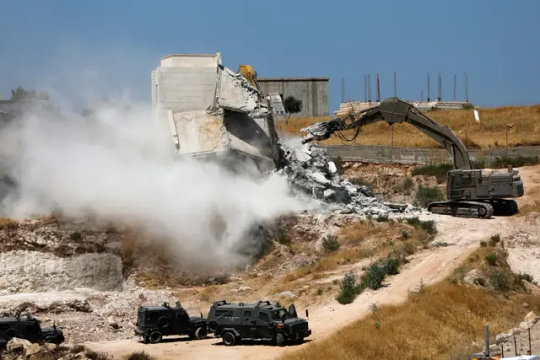
In cases of public infrastructure, bulldozers were used to crush the main water pipelines of Al-Auja. The iof forced their way into the village and welded-shut the sole pipeline which supplies water to more than 1,200 people and used a bulldozer to crush it beneath the land. This is part of a larger history of Israeli oppression, specifically in regard to stolen water, which is supplied to Israeli settlements (it also forces Palestinians to buy water directly from Israel).
Outside of home and public infrastructure demolitions, the military bulldozers are also used in Israeli raids. In August this year (2023), the IOF raided Nablus in the Balata refugee camp, accompanied by a military bulldozer that destroyed several homes. I can't even pick a date for raids in Jenin refugee camp, which has been raided continuously this year and years before, but Israeli bulldozers have been filmed tearing up streets in Jenin and leaving them in rubble, making the roads unusable.
The Armenian quarter is not safe from settler encroachment either, as demolitions in the West Bank continue, real estate companies have sent in settlers and bulldozers to steal land belonging to Armenian Church property and Several Armenian families. Settler attacks have continued on the Armenian community and Palestinian Armenians have been getting arrested for defending themselves from these mobs.
And now, we have not only gotten the confirmation that these D9s will be used in Gaza but images, testimonies, and videos of them being used on Gazan homes and infrastructure. They are also being used to crush Palestinians to death just as Rachel Corrie had been in 2004, just as those Palestinian families had been in 2002-2004, and (extreme trigger warning for mutilation of a corpse) videos are circulating of Israelis flattening already deceased Palestinians with bulldozers out of pure contempt for us. Almost 20 years since Israel demolished thousands of homes in Gaza (not even including the genocidal bombings campaigns and the blockade Israel has placed on Gaza for years), now they're back destroying anything in their path.
I will repeat: these bulldozers are death machines and are designed to be so. Caterpillar is complicit, the US is complicit, and both are actively benefiting from the mass murder and displacement of Palestinians. Keep your eyes on Gaza but also remember the Armenian Quarter and the West Bank, all of Palestine is under threat of demolitions.
14K notes
·
View notes
Text
youtube
#youtube#militarytraining#May 2024#Estonia#NATO#International Relations#Army#Training#Air Force#Combat#Security#British Military#Special Forces#Joint Operations#Deployment#Military Training#Defense#Soldiers#Airborne Mission#Military Exercise#Paratroopers#U.S. Military#Tallinn 2024#military exercise 2024#NATO Drill#joint operations#82nd Airborne#army training#military maneuvers#military deployment
2 notes
·
View notes
Text
Despite Sparta’s reputation for superior fighting, Spartan armies were as likely to lose battles as to win them, especially against peer opponents such as other Greek city-states. Sparta defeated Athens in the Peloponnesian War—but only by accepting Persian money to do it, reopening the door to Persian influence in the Aegean, which Greek victories at Plataea and Salamis nearly a century early had closed. Famous Spartan victories at Plataea and Mantinea were matched by consequential defeats at Pylos, Arginusae, and ultimately Leuctra. That last defeat at Leuctra, delivered by Thebes a mere 33 years after Sparta’s triumph over Athens, broke the back of Spartan power permanently, reducing Sparta to the status of a second-class power from which it never recovered.
Sparta was one of the largest Greek city-states in the classical period, yet it struggled to achieve meaningful political objectives; the result of Spartan arms abroad was mostly failure. Sparta was particularly poor at logistics; while Athens could maintain armies across the Eastern Mediterranean, Sparta repeatedly struggled to keep an army in the field even within Greece. Indeed, Sparta spent the entirety of the initial phase of the Peloponnesian War, the Archidamian War (431-421 B.C.), failing to solve the basic logistical problem of operating long term in Attica, less than 150 miles overland from Sparta and just a few days on foot from the nearest friendly major port and market, Corinth.
The Spartans were at best tactically and strategically uncreative. Tactically, Sparta employed the phalanx, a close-order shield and spear formation. But while elements of the hoplite phalanx are often presented in popular culture as uniquely Spartan, the formation and its equipment were common among the Greeks from at least the early fifth century, if not earlier. And beyond the phalanx, the Spartans were not innovators, slow to experiment with new tactics, combined arms, and naval operations. Instead, Spartan leaders consistently tried to solve their military problems with pitched hoplite battles. Spartan efforts to compel friendship by hoplite battle were particularly unsuccessful, as with the failed Spartan efforts to compel Corinth to rejoin the Spartan-led Peloponnesian League by force during the Corinthian War.
Sparta’s military mediocrity seems inexplicable given the city-state’s popular reputation as a highly militarized society, but modern scholarship has shown that this, too, is mostly a mirage. The agoge, Sparta’s rearing system for citizen boys, frequently represented in popular culture as akin to an intense military bootcamp, in fact included no arms training or military drills and was primarily designed to instill obedience and conformity rather than skill at arms or tactics. In order to instill that obedience, the older boys were encouraged to police the younger boys with violence, with the result that even in adulthood Spartan citizens were liable to settle disputes with their fists, a tendency that predictably made them poor diplomats.
But while Sparta’s military performance was merely mediocre, no better or worse than its Greek neighbors, Spartan politics makes it an exceptionally bad example for citizens or soldiers in a modern free society. Modern scholars continue to debate the degree to which ancient Sparta exercised a unique tyranny of the state over the lives of individual Spartan citizens. However, the Spartan citizenry represented only a tiny minority of people in Sparta, likely never more than 15 percent, including women of citizen status (who could not vote or hold office). Instead, the vast majority of people in Sparta, between 65 and 85 percent, were enslaved helots. (The remainder of the population was confined to Sparta’s bewildering array of noncitizen underclasses.) The figure is staggering, far higher than any other ancient Mediterranean state or, for instance, the antebellum American South, rightly termed a slave society with a third of its people enslaved.
3K notes
·
View notes
Text
Key Developments
Israel deploys 15,000 soldiers and military police in West Bank and Jerusalem ahead of Ramadan, including 5,000 reservists, 24 battalions, 20 Border Police companies, and two special forces units.
Hamas’s Izz El-Din Al-Qassam Brigades spokesperson rules out any breakthrough in ceasefire talks, and describes Israel’s position as “deceptive.”
Abu Obaida warns that Israel’s campaign of starvation against Palestinians in Gaza is affecting Israeli captives, some of whom “suffer from hunger, malnutrition and dehydration.”
Izz El-Din Al-Qassam Brigades announces names of four out of seven Israeli captives who died “due to the aggressive Israeli raids on the Gaza Strip.”
25 Palestinian children have died of malnutrition and dehydration since March. The total death toll in Gaza surpasses 31,000 people, 72 percent of whom are women and children.
Gaza City municipality says Israel destroyed a one-million-meter square of roads in the Gaza Strip.
Gaza City municipality needs heavy vehicles and fuel supplies to clean rubble and nearly 70,000 tons of rubbish.
Rescue teams transfer 37 bodies of Palestinian martyrs and 118 injured people to Al-Aqsa Martyrs Hospital in Deir Al-Balah overnight.
U.S. to send army vessel to Eastern Mediterranean to deliver aid and supplies to Gaza.
Wafa reports that Israeli bombing of tents of displaced Palestinians killed 15 people in Al-Mawasi area, west of Khan Younis.
Spain is considering recognizing a Palestinian state by 2027, according to Prime Minister Pedro Sanchez.
#israel#gaza strip#gazaunderattack#israel is a terrorist state#free gaza#genocide#gaza#free palestine#palestine#jerusalem#news#palestine new#rafah#israeli occupation#west bank#fuck israel#yemen#lebanon#tel aviv#spain#2027#hamas#israeli apartheid#boycott israel#this is genocide#stop genocide#cultural genocide#end the genocide#al aqsa storm#free al aqsa
975 notes
·
View notes